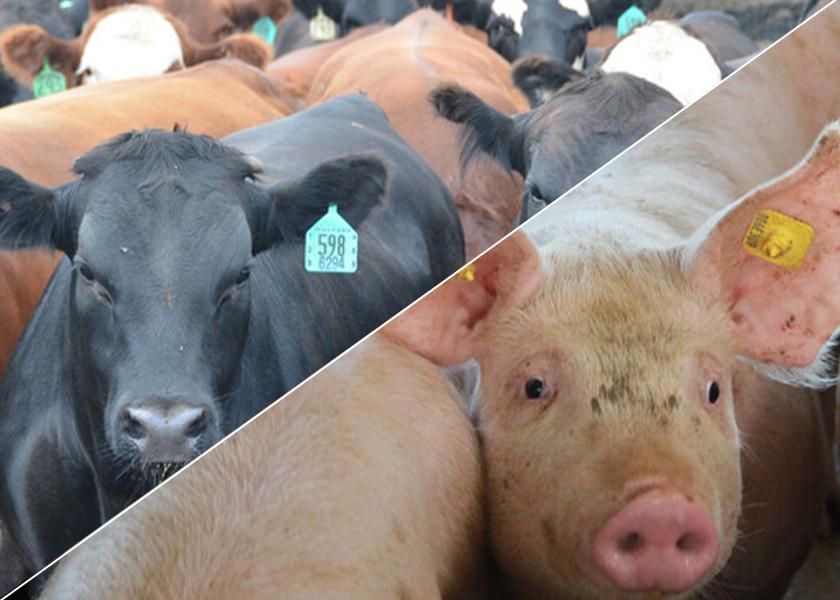Livestock Analysis | February 25, 2022

Price action: April lean hogs dropped $1.85 to $103.675, the lowest closing price since Feb. 14 and down $5.725 for the week. June futures fell $2.225 to $113.875, down $4.75 for the week.
5-day outlook: This week’s price action looked like a seasonal late-winter top, considering futures posted contract highs before falling sharply the final three days of the week. Active followthrough selling early next week would confirm a deeper corrective pullback is underway. But if buyers resurface early next week, this week’s declines would amount to a correction in a bull market. Technicals will likely overshadow fundamentals, but the CME lean hog index is projected to rise 36 cents to $98.40 on Monday (as of Feb. 24), which would be the highest since Sept. 7 and suggests the cash market may have further upside.
30-day outlook: Seasonally, it’s common for hog futures to post a late-winter top, followed by several weeks of pressure before the market starts to climb to a summertime peak. If futures confirm this week’s price action as a seasonal top, short-term hedges in April futures may be needed. April hog still hold more than a $5 premium to the cash index. Whether wholesale pork can extend recent strength will also influence futures. Pork cutout values rose $1.07 early today to $115.20, up from $109.91 at the end of last week..
90-day outlook: Summer month hog futures are likely to follow the April contract lower if it pulls back over the next couple weeks to month. But we aren’t as interested in locking in summertime hog prices at current levels since last year’s cash index peak was just below $123 and slaughter numbers are projected to be down 3% to 4% from year-ago.
What to do: You are hand-to-mouth on corn-for-feed and soybean meal needs. Wait on an overdue corrective pullback to extend coverage.
Hedgers: Carry all risk in the cash market for now.
Feed needs: You remain hand-to-mouth on soybean meal and corn-for-feed needs.
Price action: April live cattle fell 37.5 cents to $141.925, the lowest closing price since Jan. 27 and a $3.95 weekly decline. March feeder cattle rebounded 92.5 cents to $160.025, still down $5.40 for the week.
5-day outlook: Concerns about the spring demand outlook, particularly considering the Russia-Ukraine war, contributed to aggressive selling this week, despite further gains in cash cattle. Live steers through yesterday averaged slightly over $143.00, up from $142.36 last week. The pessimism was probably spurred in part by the ongoing decline in beef cutout values. Choice cutout values averaged $259.77 at midsession today, a drop of about $6.50 from a week prior. Given that it was the last full week of the month, the drop wasn’t surprising, but bulls probably won’t become more active until they see fresh wholesale strength. USDA’s Cattle on Feed report released after today’s close showed animals sent to feedlots in January totaled an estimated 1.999 million head, down 1.2% from the same month in 2021 and larger than trade expectations for a decline of about 0.8%. Cattle on feed as of Feb. 1 totaled 12.199 million head, up 0.8% from a year earlier.
30-day outlook: Grocers will likely accelerate their beef buying during the first half of March as they gear up for planned early-April features. However, the persistence of greatly elevated retail prices, as well as the late arrival of Easter on April 17 will probably reduce early-April activity in grocery stores. That implies persistently stunted packing industry demand for fed cattle, although the supply of market-ready feedlot cattle is likely to remain near annual lows through much of March. The anticipated onset of spring grilling season later in the month often more than offsets the seasonal increase in fed cattle supplies and fed cattle prices tend to work higher.
90-day outlook: Cash prices for fed cattle typically rally to annual highs during April, then turn seasonally lower into summer. That usually reflects a surge in fed cattle supplies roughly matching the usual late summer-early fall placements of calves. The fact that the spread between Choice- and Select-grade beef values widens sharply during that period reflects the strong rise in calf-fed animals in the slaughter mix at that time. Demand from grocers and consumers routinely remains relatively strong into mid-June, when grocers complete their buying for planned Independence Day features. We suspect the market will prove vulnerable to the seasonal price decline this summer, due in part to the seemingly plentiful supply of market-ready cattle in feedlots at this time, as well as to the comparative strength of deferred futures, which disincentivizes accelerated marketings on the part of feedlot managers.
What to do: You are hand-to-mouth on corn-for-feed and soybean meal needs. Wait on an overdue corrective pullback to extend coverage.
Hedgers: Carry all risk in the cash market for now.
Feed needs: You remain hand-to-mouth on soybean meal and corn-for-feed needs.






